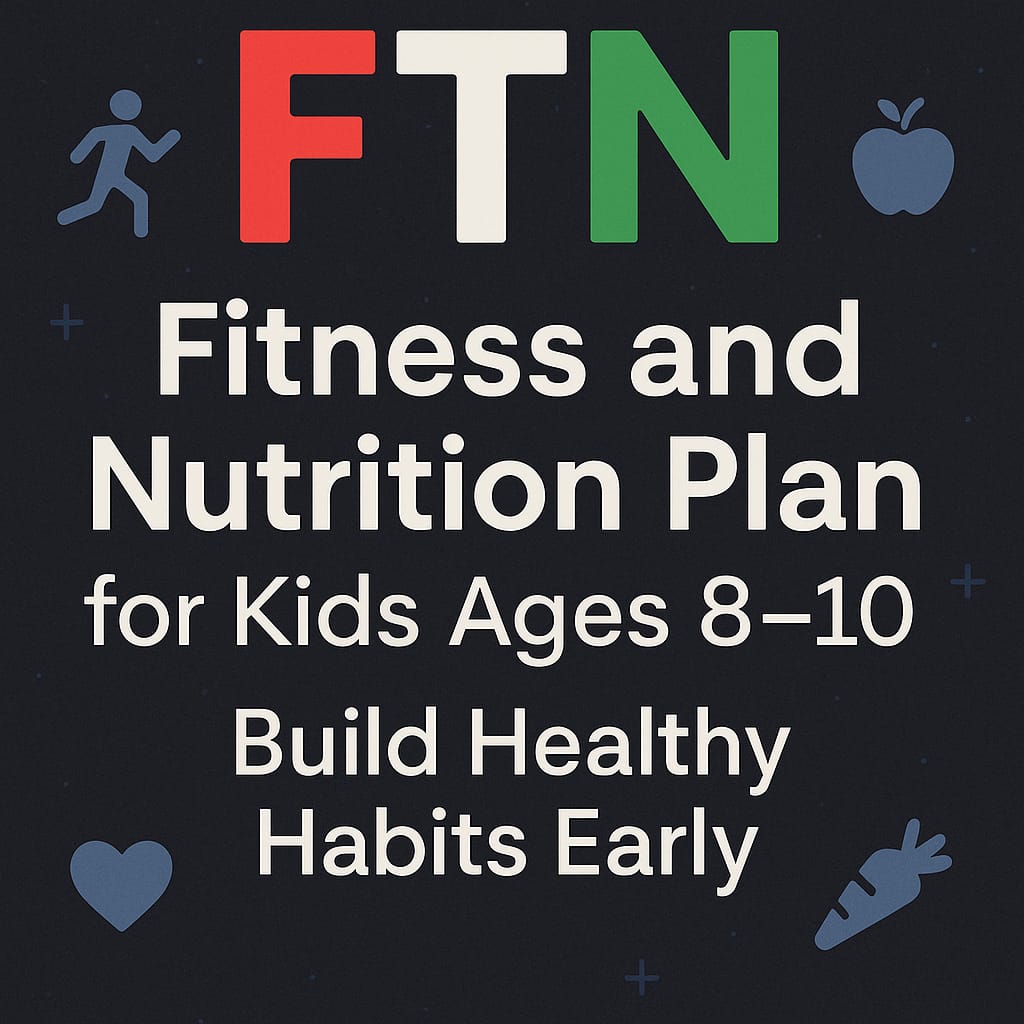Understanding the Importance of Fitness and Nutrition for Kids 🧒🍎🏃
Children between the ages of 8 and 10 are in a critical stage of growth—physically, mentally, and emotionally. These are the years when their bodies are growing rapidly, their minds are expanding, and their social skills are developing. That’s why fitness and nutrition are so important during this time. Together, they form the foundation for a child’s long-term health, well-being, and lifestyle habits.
Encouraging kids to move more and eat better doesn’t just help them grow stronger—it also improves their focus at school, boosts their mood, and helps them build confidence. In this article, we’ll explore how a balanced combination of exercise and healthy eating benefits kids, and how parents can help children adopt these habits early on.
The Power of Movement: Why Physical Activity Matters 🏸⛹️♀️
Physical activity offers countless benefits for children, especially at the ages of 8 to 10. At this age, kids have natural energy, curiosity, and a desire to play. Tapping into that energy with structured or unstructured physical activity can:
Improve cardiovascular health ❤️
Strengthen muscles and bones 💪
Support coordination and flexibility 🤸
Reduce stress and anxiety 😌
Boost self-esteem and social skills 👯
Whether it’s a soccer game after school, a dance class, or simply playing outside, active kids are healthier and more confident. Exercise also helps kids focus in school, which can lead to better grades and stronger classroom behavior.
Experts recommend that children get at least 60 minutes of physical activity per day. This doesn’t have to happen all at once—short activities throughout the day count too!
Smart Eating: Building a Strong Body from the Inside Out 🍽️🥦
While staying active is essential, food is the fuel that powers a child’s body and brain. A balanced diet helps children stay energized, grow properly, and stay focused throughout the day.
Key components of a healthy diet include:
Proteins for muscle development (chicken, fish, eggs, beans)
Carbohydrates for energy (whole grains, fruits, vegetables)
Healthy fats for brain function (avocados, nuts, olive oil)
Vitamins and minerals for immune support and growth (fruits, leafy greens, dairy)
Kids should eat colorful meals that include a variety of fresh, whole foods. Avoiding too many sugary snacks and processed foods can help them maintain a healthy weight and prevent early signs of chronic illnesses like obesity and diabetes.
💡 Tip: Make meals fun by letting kids help with cooking, choosing ingredients, or even naming the dish!
Fun Ways to Stay Active Daily 🎯🚴♂️
Incorporating exercise into a child’s daily life doesn’t have to be boring or feel like a chore. In fact, the more fun it is, the more likely kids are to stick with it.
Here are some enjoyable ideas:
Jump rope competitions 🪢
Dance parties at home 💃🕺
Obstacle courses in the backyard 🏃♀️🌿
Family bike rides or walks 🚶♂️🚲
Sports like basketball, soccer, or swimming 🏀🏊
For kids who aren’t interested in team sports, solo activities like martial arts, skating, or yoga can be great options.
Encourage variety to prevent boredom and allow kids to explore what they truly enjoy. What matters most is consistency and enjoyment.
Portion Control & Healthy Snacking 🥪🍌
Understanding how much to eat is just as important as knowing what to eat. Portion control helps kids avoid overeating while learning to listen to their hunger cues.
Here’s how parents can guide them:
Use smaller plates and bowls to encourage appropriate servings 🍽️
Teach them to eat slowly and stop when they feel full ⏳
Avoid distractions like TV during meals 📺🚫
When it comes to snacking, swap out sugary or salty processed snacks with options like:
Apple slices with peanut butter 🍏
Yogurt with granola and berries 🥣
Carrot sticks with hummus 🥕
Whole grain crackers or air-popped popcorn 🍿
Let kids help choose or prepare their snacks to give them a sense of control and excitement over their choices.
Setting Achievable Fitness Goals for Kids 🎯📅
Helping kids set simple fitness goals can keep them motivated and focused. Involve them in choosing their own goals—this way, they feel empowered and committed.
Examples of realistic goals include:
“I want to ride my bike every afternoon this week.”
“I want to learn how to do a cartwheel by the end of the month.”
“I want to run one mile without stopping.”
Make sure goals are:
Specific
Measurable
Achievable
Relevant
Time-bound (SMART)
Celebrate milestones with rewards like a fun family outing, a new soccer ball, or even just verbal praise and encouragement. 🎉
Making Health a Family Affair 👨👩👧👦💚
Children learn most by watching their parents. When families eat healthy meals together and stay active, children are more likely to develop positive habits too.
Ideas to try as a family:
Weekly family sports days
Cooking healthy dinners together
Grocery shopping as a team and picking new fruits or vegetables to try
Creating a fun “move for 10 minutes” challenge every day
By modeling a healthy lifestyle and supporting your child’s efforts, you create a lasting impact that extends into their teenage years and beyond.
Involving Kids in Cooking 🧑🍳🥗
Letting children help in the kitchen gives them a sense of ownership over their food choices. It also teaches them basic nutrition, meal planning, and cooking skills.
Easy ways to include them:
Let them wash veggies or stir ingredients
Give them small tasks like tearing lettuce or measuring oats
Choose recipes together from a kid-friendly cookbook
Decorate their own healthy pizza or build their own wraps
When children are part of the process, they’re more excited to eat the meals they’ve helped create!
Keep Them Hydrated! 💧🚰
Water is essential for kids’ physical and mental performance. It helps with digestion, energy, temperature regulation, and focus. Dehydration can lead to fatigue, headaches, and mood swings.
Encourage kids to drink:
A glass of water with every meal
Water before, during, and after physical activity
Infused water with slices of fruit for added flavor 🍓🍋
Avoid sugary sodas and juices with added sugars. Instead, aim for plain water, milk, or unsweetened alternatives as the primary drinks.
Tools and Resources for Parents 🛠️📚
There are plenty of tools and platforms available to help parents guide their kids toward healthier lifestyles:
ChooseMyPlate.gov – Interactive guides on nutrition and portion control.
HealthyChildren.org – Advice from pediatricians about diet, activity, and sleep.
Fitness apps like GoNoodle or Just Dance – Fun, movement-based platforms for kids.
Cookbooks like The Ultimate Kids’ Cookbook – Fun and simple healthy recipes.
Also, check your local community centers or schools for classes, workshops, or events promoting health and fitness.
Final Thoughts: Healthy Habits Start Young 🌱✨
Helping kids develop healthy eating habits and stay active isn’t about perfection—it’s about progress. What children learn now will shape how they live as teens and adults.
By making fitness and nutrition fun, simple, and part of daily life, we set our kids up for a brighter, healthier future. So get moving, get cooking, and build those healthy routines together—your child’s future self will thank you!
🎥 My Personal Insight – “GET STRONG” KIDS WORKOUT
I really appreciate how this video delivers a full-body kids workout using simple, playful exercises that build strength, coordination, and energy—all at a level that’s safe and fun for 8 to 10 year olds. The instructor’s lively teaching style and clear movement cues make it easy for young viewers to follow along confidently, whether it’s after school or during a weekend play session.
For added value, I would love to see a short warm-up and cool-down included to emphasize safe practice—perhaps 2 minutes of light stretching at the beginning and end. Additionally, incorporating positive affirmations like “Great job!” or “You’re doing awesome!” throughout the routine could further boost kids’ motivation and confidence.
In summary, this workout pairs wonderfully with the article’s themes of fun fitness and building healthy habits early. It’s an excellent, screen-friendly activity that parents and kids can do together—and ideally return to regularly

